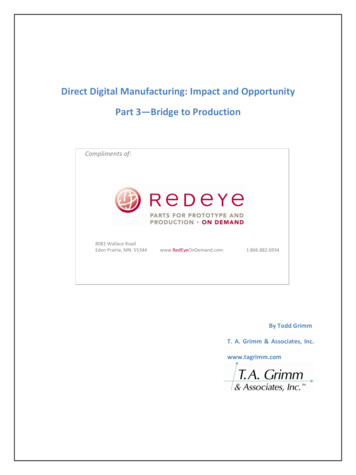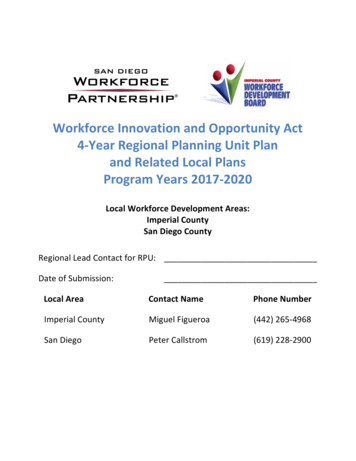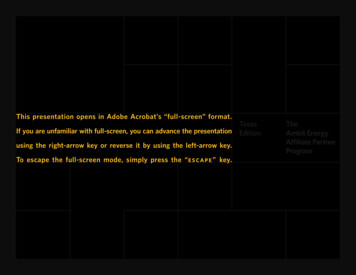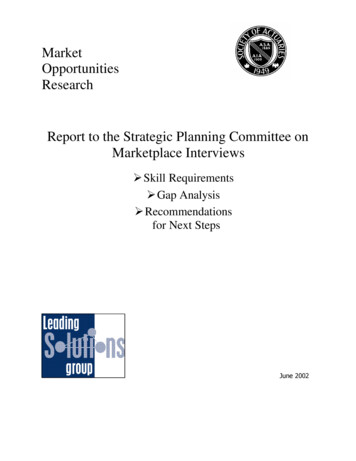
Transcription
Direct Digital Manufacturing: Impact and OpportunityPart 3—Bridge to ProductionCompliments of:8081 Wallace RoadEden Prairie, MN 55344www.RedEyeOnDemand.com1.866.882.6934By Todd GrimmT. A. Grimm & Associates, Inc.www.tagrimm.com
PREFACEDirect digital manufacturing, otherwise known as rapid manufacturing, is a process that employsadditive fabrication technology (aka rapid prototyping) to produce end-use items. Directly from CADdata, components are manufactured without molding, casting or machining. The impact of direct digitalmanufacturing is far-reaching, and the opportunities and advantages are extensive. This is why directdigital manufacturing is heralded as the next industrial revolution.Since the earliest days of rapid prototyping, experts have envisioned the application of the technology inthe manufacturing process, and the focus of this vision has been on the initial cost and time savings thatare realized when tooling is eliminated. However, the relative impact pales in comparison to the wideranging advantages that exist when rapid manufacturing is implemented.Industry has failed to recognize many of the opportunitiesthat direct digital manufacturing offers. Some will yieldunprecedented efficiencies; some will generate annualsavings that far exceed the cost of a tool; and others willfacilitate new methodologies that address age-oldconstraints. Direct digital manufacturing will benefit nearlyevery discipline within a manufacturing organization, and itwill change fundamental business processes. When adopteden masse, it truly will be an industrial revolution.In this series of white papers, the often unrecognizedbenefits of rapid manufacturing will be disclosed to revealthe huge potential that the process offers. Part 1 discussedthe positive impact of a newfound freedom to redesign oralter products while in production. In Part 2, the discussionhighlighted direct digital manufacturing’s elimination ofdesign constraints imposed by conventional processes. InPart 3, we investigate direct digital manufacturing’s role as abridge to production.Direct Digital Manufacturing“Rapid Manufacturing” has become ageneric term that is applied to anyprocess that produces manufacturedgoods quickly. To avoid confusion, theSociety of Manufacturing Engineershas adopted a new term, direct digitalmanufacturing. The association’sdefinition of direct digitalmanufacturing is “The process ofgoing directly from an electronic,digital representation of a part to thefinal product via additivemanufacturing. “STATUS QUOBridge to production is not a technology. It is a method, tactic and strategy to overcome the time delaybetween the present and the anticipated date for receipt of tools or parts. Bridging the gap allowsmanufacturers to meet production schedules when problems are discovered or tooling is delayed. It isalso an alternative for accelerating product launches or piloting new products. In each case, the goal isto use an alternative manufacturing approach that offers shorter lead times with reasonable costs.[2]Compliments of RedEye On Demand (www.RedEyeOnDemand.com)Copyright 2007 T. A. Grimm & Associates, Inc.
Although bridge to production is commonly associated with tooling, as in the often used phrase “bridgeto-production tooling,” molds and dies are not the desired outcome. What manufacturers want areparts, components that can be used in their products. Whether as a short-term fix or a long-termsolution, manufactures of high-volume products frequently find themselves needing rapid delivery of asmall quantity of production-grade components. Without them, product launches are delayed andmanufacturing comes to a grinding halt.Another scenario is also quite common. Manufacturerswhose unit sales do not number in the millions may apply adirect digital manufacturing solution as the primaryproduction process. To avoid the investment in a steel toolfor injection molding, for example, low-volumemanufactures use the bridge-to-production processes toaccelerate delivery and lower the investment in tooling.While the part cost may be higher and the cycle time longer,production runs of hundreds or thousands of parts arecompleted faster and cheaper than if high-volumeproduction tooling were used.Bridge to Production:Any process that overcomes thetime delay between the presentand the anticipated date forreceipt of tooled parts.Historically, manufactures commonly used one of four processes as a bridge-to-production solution.Listed in ascending order of viable production quantities, first article lead time and upfront cost as wellas descending order of unit cost, these processes are: Machining Rubber molding Reaction injection molding (RIM) Injection molding (machined aluminum tools)Selecting a bridge-to-production process from this list of alternatives requires an evaluation of technical,financial and business requirements. Since the bridge-to-production methods are not identical to theproduction process, concessions are required.Every process has its own set of constraints, so there may be alterations to the design, substitution ofmaterials and reduction of order quantity. Additionally, with the exception of machined parts, each ofthese alternatives requires tooling, which bars immediate delivery and requires an investment in moldsthat will be discarded when the production tool is online.The underlying factor is always the ability of the parts to perform as specified, and this must be matchedto the quality and quantity needed as well as the total cost for tooling and parts. Yet, the overridingissue is lead time. For every day that production is halted, revenues decline, inventory mounts andschedules slip. Therefore, the ultimate goal is to deliver product as fast as possible while minimizing costs.[3]Compliments of RedEye On Demand (www.RedEyeOnDemand.com)Copyright 2007 T. A. Grimm & Associates, Inc.
BRIDGE TO PRODUCTIONWith direct digital manufacturing, bridge to production is fast, simple and flexible. In the time it takes toreceive a quote for conventional, bridge-to-production processes, direct digital manufacturing candeliver parts that keep manufacturing churning. With less upfront effort and no commitments, it can beimplemented quickly, and it is adaptable to changes in product designs or production schedules.The moment a delay or problem is discovered,companies can enact a direct digital manufacturingsolution that delivers production-grade componentsin as little as a day. All that is required is 3D CAD data,machine capacity and materials. Eliminating nearly allsteps required in conventional, bridge-to-productionprocesses, including tool path design and tool making,direct digital manufacturing simplifies the process,minimizes effort and expedites manufacturing. Unlikeconventional approaches that become big projects,direct digital manufacturing is a task, just one item ona manufacturing engineer’s to-do list.In the time it takes to receive a quote forconventional, bridge-to-production processes,direct digital manufacturing can deliver parts thatkeep manufacturing churning.As mentioned earlier, alternative bridge-toproduction methods often demand design modifications to accommodate process constraints andaccelerate product delivery. Days, even weeks, are lost in the discussion of suggested changes,evaluation of the viability and impact, and modification of the design data. Since direct digitalmanufacturing has few constraints, there is rarely a need for discussion, evaluation or inclusion ofdesign modifications. With no alteration, production is initiated directly from an STL of the originaldesign. And since there is no tooling, production begins immediately.To overcome schedule delays, the rapid response of directTip: Capitalize on the freedom ofdigital manufacturing is critical. However, there is anotherdesign. If more than one componentimportant factor to consider. Direct digital manufacturingin an assembly requires a bridge-tocan adapt to any changes that occur while waiting forproduction solution, considerproduction tooling. By the nature of the additive process,consolidating these parts into one.there is unlimited flexibility. Contrary to conventionalprocesses where designs become frozen and orderquantities are predetermined, direct digital manufacturing supports design modifications and allowsfrequent adjustments to quantities and delivery schedules.Part 1 of this series of articles discussed that the elimination of tooling promotes design changes while aproduct is in production. This is also true in the case of bridge to production. Manufacturers receiveparts that serve as prototypes, pilots and production goods. Should the parts reveal a design flaw,[4]Compliments of RedEye On Demand (www.RedEyeOnDemand.com)Copyright 2007 T. A. Grimm & Associates, Inc.
changes can be made and implemented with the next batch of parts. If discovered early, these changesmay be incorporated into the production tooling.With direct digital manufacturing, there are no minimumTip: Evaluate the quantity of partsorder quantities and no penalties for re-orders. Thisneeded. When considering multipleprovides manufactures the flexibility to purchase asolutions, companies may arbitrarilyminimum quantity and specify a delivery schedule thatspecify an order quantity dictated bymatches the shop floor demand. Should the production toolthe efficiencies of molding processescome online earlier or later than planned, direct digitalrather than the actual demand.manufacturing allows schedule and quantity adjustments.For example, if using an aluminum injection mold as abridge to production, costs are minimized and efficiencies maximized if all parts are molded in one run.Breaking down and setting up tools on the molding press takes time, and this translates to additionalcosts and delays if a re-order is required. In the case of rubber molding, an additional order may exceedthe life of the mold, so another has to be constructed. Neither scenario is true with direct digitalmanufacturing. There is no penalty for frequent re-orders, decreases in anticipated order quantity orincreases in total number of parts required.Capitalizing on the on-demand nature of direct digital manufacturing, companies can adapt to anychanges in the production plan. In fact, the ideal direct digital manufacturing scenario is to order onlythe quantity needed over the course of a few days or a week. With production schedule in hand, areplenishment order is placed to satisfy the needs for the coming period. This assures no scrap, noshortages and no delays to the production schedule. No other bridge-to-production method offers thisability to deliver small quantities rapidly and with no impact on costs or schedules.Direct digital manufacturing is an ideal bridge-to-production solution because it is fast, simple andflexible. Delivering parts just days after a problem is discovered, it keeps production schedules on track,and it does so without the overhead, burdens, efforts and decision-making of alternative approaches. Ata time when an organization is in a frenzy of activity to launch a product, the simplicity and flexibilityfrees the manufacturing staff to move on to other challenges that inevitably crop up when launching anew product.RETURN ON INVESTMENTThe undeniable financial benefit of direct digital manufacturing is the additional profit generated fromproduct sales during the time span between the present and the delivery of parts from productiontooling. As the example shows, a company with 10 million in annual sales can realize 500,000 inadditional gross profit with direct digital manufacturing.However, there are additional financial gains to consider. While measureable, they vary greatly fromcompany-to-company, so an example is not offered.[5]Compliments of RedEye On Demand (www.RedEyeOnDemand.com)Copyright 2007 T. A. Grimm & Associates, Inc.
These gains include: ROI CALCULATIONCash flow:Assumptionso A delay in sales can constrict cash flow,which may force a company to borrowmoney or tap into sources of income orinterest generating funds.Number of parts per product:25No. requiring bridge to production:1Weeks saved:5Number of products:10Annual sales per product: 1,000,000Gross profit:50%Facilities and equipment:Profit Gainso Whether idle or operating, there arefixed expenses associated with thefacilities, tooling, equipment, productionlines and assembly lines.Inventory carrying costoSales:Weekly gross profit: 1,000,000/50 weeks:X 50% gross profit:X 10 products:Gross profit:5 weeks @ 100,000: 20,000 10,000 100,000 500,000A delay in production tooling createslarge work-in-progress (WIP) inventories for the balance of a product’s components. Foreach day that inventory sits on a shelf, there is a direct cost to the company.Delays are costly. Eliminating them yields significant and measurable financial benefits. However, thereare also other advantages and gains that cannot be directly translated into financial terms. While theystem from the same factors— speed, simplicity and flexibility—they are not quite as tangible.ProductivityNotice of a tooling delay sends the manufacturingstaff scrambling for a solution. All planned actions areput on hold while an alternative is sought. Thisunexpected activity diminishes manufacturingproductivity.Conventional bridge-to-production solutions requirediscussion, analysis, decisions, documentation andoversight. From the moment a quotation request issubmitted until the last part is received,manufacturing employees will be actively involved inthe bridge-to-production project. The time demandspostpone other important, but not as critical, projectsand tasks. While there is a direct labor cost associatedto this work, the biggest impact is on the overallproductivity of manufacturing and shop floor personnel.Direct digital manufacturing gets production backon track while minimizing productivity declines.Production begins immediately, and since thetechnology is so fast, so automated and soindependent of other processes, parts can beproduced in a single day.[6]Compliments of RedEye On Demand (www.RedEyeOnDemand.com)Copyright 2007 T. A. Grimm & Associates, Inc.
As stated previously, direct digital manufacturing is more of a task than a project. While technologiesand materials need to be evaluated, the balance of the bridge-to-production effort can be executed withlittle direct labor. From an STL file, a quote is prepared and submitted, often within hours. There are nodiscussions or negotiations of design modifications. Once the order is released, production beginsimmediately, and since the technology is so fast, so automated and so independent of other processes,there is much less likelihood of a second round of delays and schedule juggling. Direct digitalmanufacturing gets production back on track while minimizing productivity declines.EfficiencyManufacturing operations are intertwined, tightly coupled and carefully sequenced. When oneoperation fails to deliver as scheduled, all connected operations are affected and inefficiencies mount.And since people, equipment and operations are often shared amongst products, the lag on one productmay have a ripple effect on all others.Shifting manpower, breaking down lines and juggling schedules lead to inefficiencies that have a directimpact on profitability, capacity and throughput. With a direct digital manufacturing solution,unexpected delays in production tooling are bridged, and operational efficiency is protected.Reputation & CommitmentsThe impact of a manufacturing delay reaches far beyond themanufacturing floor. Missed delivery dates rise to theexecutive level of the corporation, spread throughout alldepartments and extend to the customer. The ramificationsare deep, wide and impossible to quantify.Missed delivery dates rise to theexecutive level of thecorporation, spread throughoutall departments and extend tothe customer.Using direct digital manufacturing to preserve promisedlaunch dates allows customers, as well as corporate sales,marketing and finance, to operate to predefined schedules.Without the rapid response to manufacturing delays, theinefficiency, turmoil and cost that would affect the manufacturing floor are passed on to otherdepartments and corporate entities. Manufacturing copes with the fact that schedules are tough tokeep, even when there are no outside influences. When a schedule is missed because of another’sactions, frustration, animosity and anger can arise, which jeopardizes long-term relationships, and in thecase of the customer, risks future sales.[7]Compliments of RedEye On Demand (www.RedEyeOnDemand.com)Copyright 2007 T. A. Grimm & Associates, Inc.
CONCLUSIONReputation is priceless. Productivity and efficiency add value. Delivering on schedule raises profits. As abridge-to-production solution, direct digital manufacturing delivers these benefits. Quick, simple andefficient, it is the ideal alternative when production delays are identified. Combined with the advantagesof the freedom to redesign (Part 1) and freedom of design (Part 2), the benefits are staggering andimpossible to ignore.And yet, there are even more advantages that the process offers. Part 4 in this series will reveal thebenefits gained when direct digital manufacturing is applied to jigs and fixtures. Although perceived as aprocess for making production goods, direct digital manufacturing is equally powerful as a tool formanufacturing engineering. With fewer demands and less perceived risk, it is easily adopted bycompanies of all sizes and in all industries.Direct digital manufacturing will be the next industrial revolution. With it, as with any revolution, therewill be a total upheaval, a radical change and an overthrow of existing practices. Direct digitalmanufacturing will infiltrate all processes and every discipline within a company. It will change howmanufacturing is done.About the AuthorTodd Grimm is president of T. A. Grimm & Associates, Inc., an independent consulting firm that focuseson rapid prototyping and reverse engineering. Todd has worked in the field of rapid prototyping since1990. He is the author of “Users Guide to Rapid Prototyping” and holds a Masters Certificate in RapidPrototyping. Todd serves on the Society of Manufacturing Engineers’ Rapid Technologies and AdditiveManufacturing steering committee, and he chairs the 3D Data Capture/Reverse Engineering technicalgroup.[8]Compliments of RedEye On Demand (www.RedEyeOnDemand.com)Copyright 2007 T. A. Grimm & Associates, Inc.
Since the earliest days of rapid prototyping, experts have envisioned the application of the technology in the manufacturing process, and the focus of this vision has been on the initial cost and time savings that are realized when tooling is eliminated. How











